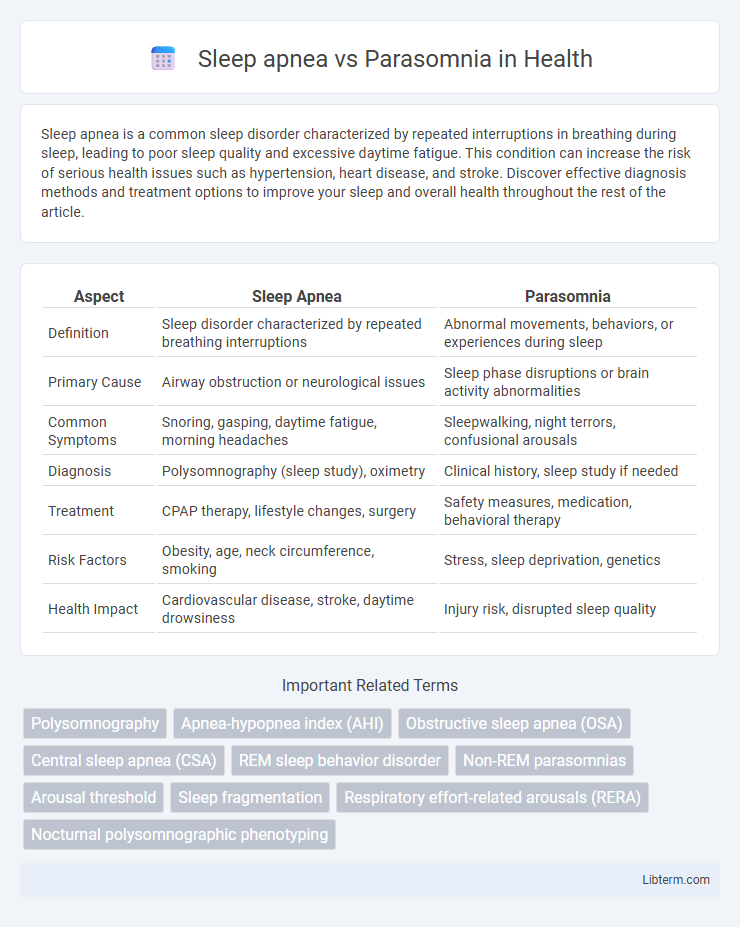Sleep apnea is a common sleep disorder characterized by repeated interruptions in breathing during sleep, leading to poor sleep quality and excessive daytime fatigue. This condition can increase the risk of serious health issues such as hypertension, heart disease, and stroke. Discover effective diagnosis methods and treatment options to improve your sleep and overall health throughout the rest of the article.
Table of Comparison
| Aspect | Sleep Apnea | Parasomnia |
|---|---|---|
| Definition | Sleep disorder characterized by repeated breathing interruptions | Abnormal movements, behaviors, or experiences during sleep |
| Primary Cause | Airway obstruction or neurological issues | Sleep phase disruptions or brain activity abnormalities |
| Common Symptoms | Snoring, gasping, daytime fatigue, morning headaches | Sleepwalking, night terrors, confusional arousals |
| Diagnosis | Polysomnography (sleep study), oximetry | Clinical history, sleep study if needed |
| Treatment | CPAP therapy, lifestyle changes, surgery | Safety measures, medication, behavioral therapy |
| Risk Factors | Obesity, age, neck circumference, smoking | Stress, sleep deprivation, genetics |
| Health Impact | Cardiovascular disease, stroke, daytime drowsiness | Injury risk, disrupted sleep quality |
Understanding Sleep Apnea: Key Features
Sleep apnea is characterized by repeated interruptions in breathing during sleep, leading to reduced oxygen levels and fragmented rest. Key features include loud snoring, excessive daytime sleepiness, and observed pauses in breathing. Unlike parasomnia, which involves abnormal movements or behaviors during sleep, sleep apnea primarily disrupts the respiratory system and sleep quality.
What Is Parasomnia? Definition and Types
Parasomnia refers to a group of sleep disorders characterized by abnormal movements, behaviors, emotions, perceptions, or dreams occurring during transitions between sleep stages. Common types of parasomnia include sleepwalking, night terrors, REM sleep behavior disorder, and confusional arousals. These episodes often disrupt sleep quality and may pose safety risks, distinguishing parasomnia from breathing-related conditions like sleep apnea.
Causes of Sleep Apnea vs Parasomnia
Sleep apnea is primarily caused by the obstruction of the airway due to relaxed throat muscles or abnormalities like enlarged tonsils, leading to interrupted breathing during sleep. Parasomnias, on the other hand, stem from abnormal brain activity during transitions between sleep stages, influenced by factors such as stress, sleep deprivation, or neurological disorders. Understanding the distinct causes of sleep apnea and parasomnia is essential for accurate diagnosis and effective treatment.
Common Symptoms: Sleep Apnea vs Parasomnia
Sleep apnea commonly presents with symptoms such as loud snoring, episodes of breathing cessation during sleep, and excessive daytime fatigue, caused by interrupted airflow and oxygen deprivation. Parasomnia typically involves unusual sleep behaviors including sleepwalking, night terrors, and vivid dreams or nightmares that disrupt normal sleep patterns. Both conditions can lead to fragmented sleep and daytime impairment but differ in their underlying causes and specific manifestations.
Risk Factors and Who’s Affected
Sleep apnea primarily affects middle-aged and older adults, with risk factors including obesity, male gender, family history, and smoking. Parasomnias, such as sleepwalking and night terrors, often impact children but can persist or appear in adults, especially those with stress, sleep deprivation, or psychiatric disorders. Both conditions can significantly disrupt sleep quality and are often linked to underlying neurological or respiratory issues.
Diagnosis: How Sleep Apnea and Parasomnia Are Identified
Sleep apnea is diagnosed primarily through polysomnography, which monitors breathing patterns, oxygen levels, and sleep stages to detect airway obstructions during sleep. Parasomnia diagnosis involves clinical evaluation, patient history, and sometimes video polysomnography to capture unusual movements or behaviors occurring in non-REM or REM sleep. Both conditions require careful differentiation using sleep studies, but sleep apnea detection emphasizes respiratory parameters, while parasomnia focuses on motor or behavioral anomalies.
Health Impacts: Short-term and Long-term Effects
Sleep apnea causes disrupted breathing during sleep, leading to short-term effects such as excessive daytime sleepiness, impaired concentration, and increased risk of accidents. Long-term health impacts include cardiovascular disease, hypertension, stroke, and type 2 diabetes due to repeated oxygen deprivation. Parasomnia involves abnormal behaviors during sleep, like sleepwalking or night terrors, causing injury risk and fragmented sleep, which can result in chronic fatigue and mental health issues if untreated over time.
Treatment Options for Sleep Apnea
Continuous positive airway pressure (CPAP) therapy remains the gold standard treatment option for obstructive sleep apnea, effectively keeping airways open during sleep. Alternatives such as oral appliances, which reposition the jaw to maintain airway patency, and surgical interventions targeting airway obstructions provide additional therapeutic pathways. Lifestyle modifications, including weight loss, positional therapy, and avoidance of alcohol or sedatives, complement medical treatments and improve overall sleep quality for sleep apnea patients.
Managing and Treating Parasomnia Disorders
Managing and treating parasomnia disorders involves improving sleep hygiene, maintaining a consistent sleep schedule, and creating a safe sleep environment to prevent injury during episodes. Pharmacological treatments, such as benzodiazepines or melatonin, may be prescribed based on specific parasomnia types like REM sleep behavior disorder or sleepwalking. Behavioral therapies, including cognitive-behavioral therapy and stress reduction techniques, can also effectively reduce the frequency and severity of parasomnia episodes.
Preventive Measures and Lifestyle Tips
Sleep apnea prevention involves maintaining a healthy weight, avoiding alcohol and sedatives before bedtime, and sleeping on one's side to keep airways open. Parasomnia management centers on establishing a consistent sleep schedule, reducing stress through relaxation techniques, and ensuring a safe sleep environment free from potential hazards. Both conditions benefit from regular medical evaluations and adherence to prescribed therapies like CPAP for sleep apnea or medication adjustments for parasomnias.
Sleep apnea Infographic

 libterm.com
libterm.com